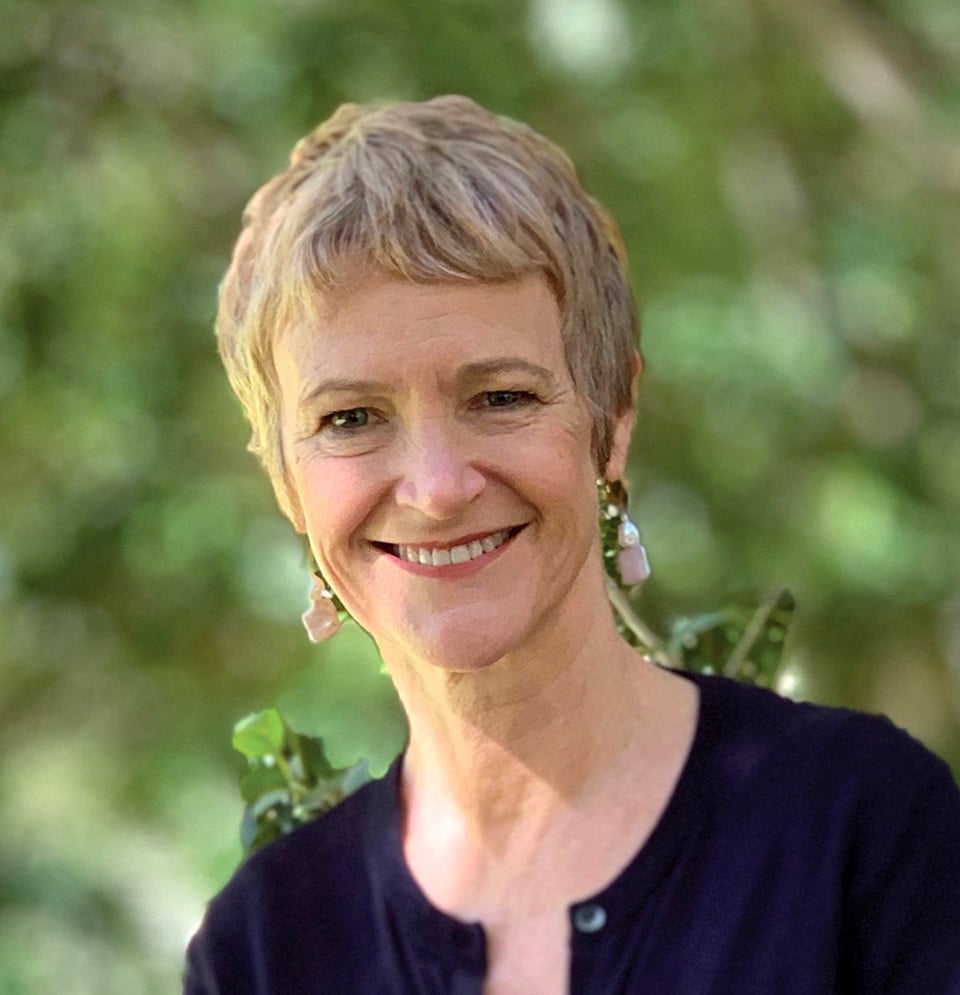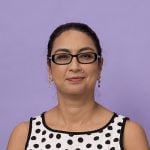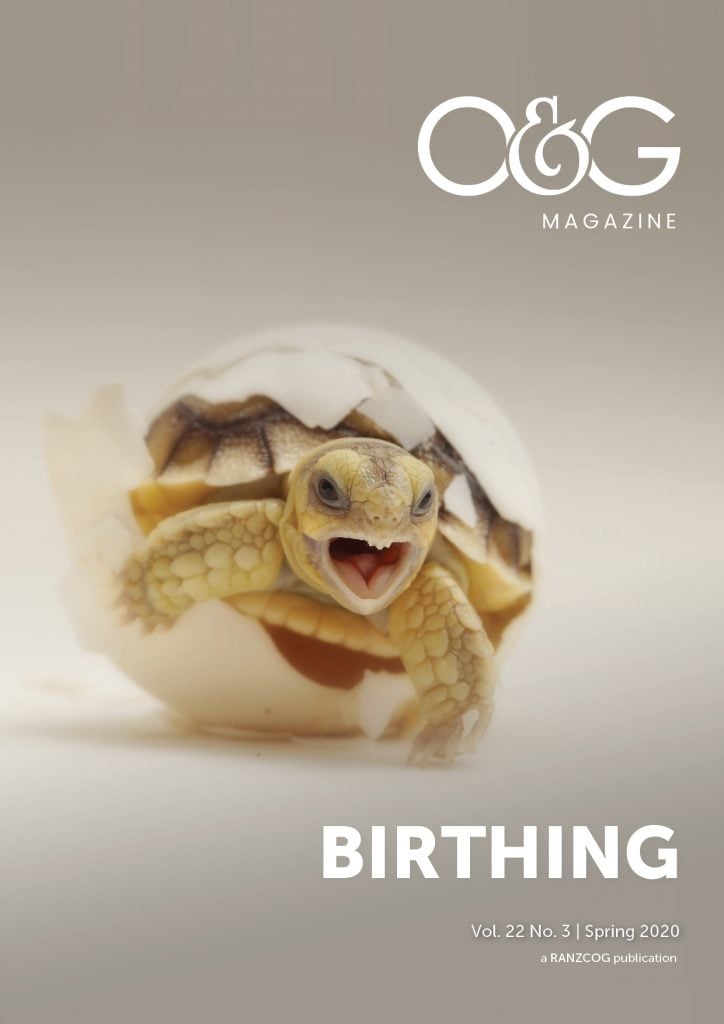This O&G Magazine feature sees Dr Nisha Khot in conversation with RANZCOG members in a broad range of leadership positions. We hope you find this an interesting and inspiring read. Join the conversation on Twitter #CelebratingLeadership @RANZCOG @Nishaobgyn
Prof Caroline Homer AO
RM, MMedSc(ClinEpi), PhD
A Birthing-themed issue would be incomplete without a midwife. An obstetrician is not needed at every birth, but every woman needs a midwife to support her during labour. WHO has declared 2020 the International Year of the Nurse and Midwife, so it seems only appropriate to feature a leader in midwifery in O&G Magazine. Recently, RANZCOG and the Australian College of Midwives signed a historic memorandum of understanding to promote collegiality between both representative bodies and, hence, between the two professions. In this Leaders in Focus, I interview Prof Caroline Homer AO and talk to her about the future of maternity care in Australia. We discuss the tricky relationship between the two closely allied professions of midwifery and obstetrics and explore global leadership in women’s health.
Prof Homer is the Co-Program Director of Maternal, Child and Adolescent Health at the Burnet Institute. She is also a Visiting Professor at the University of Technology Sydney, and an Honorary Professor at Monash University, Deakin University and the University of Melbourne. Prof Homer is a Fellow of the Australian Academy of Health and Medical Sciences. She is Co-Chair of the Australian Commonwealth Department of Health and Ageing National Expert Advisory Executive, Development of National Pregnancy Guidelines. She is a member of the World Health Organization Maternal and Perinatal Health Executive Guideline Development Group and has recently been appointed as Chair of the Strategic and Technical Advisory Group of Experts for Maternal, Newborn, Child and Adolescent Health and Nutrition. She is the President Elect of the Perinatal Society of Australia and New Zealand and has been the President of the Australian College of Midwives.

Prof Caroline Homer AO
What does a typical day look like for you?
In COVID-19 time, a typical day is working from home and working on a lot of research to do with COVID-19, but also my other research programs in the Asia Pacific region. My day begins early in the morning with Zoom meetings with the North Americans and ends late with the Europeans.
In previous years, my day also involved teaching and clinical practice, but these days it is research and development.
Can you tell me about your childhood?
I was born in what was then called Rhodesia, now Zimbabwe. My father was a cattle, tobacco and maize farmer. We lived around 100km north of Harare, the capital of Zimbabwe. We were home schooled in our early years and then went to the local school. By then, the civil war had begun in Zimbabwe. It went from the mid-70s to the 80s, and things became pretty hard and scary. My father was on police reserve, so he was away a lot of the time. We had to move houses to stay safe, we were escorted to school by an armed guard because of the risk of domestic terrorism.
When I was about 11, my parents decided to move to Australia. My father’s great-great-grandmother was born in Australia, but the family had moved to England, so he had this one matriarchal relative from Australia. We didn’t have any papers or passports, but we were told that Australia would accept us. We left Africa with no money and took a ship to Freemantle. I reckon if we arrived today, we would be sent to Nauru or Manus island. When we landed in Freemantle, we were told that we could only enter Australia if we had a patriarchal relative born in Australia, not a matriarchal relative. Even as an 11-year-old, I can remember thinking how outrageous and unfair that was. But the officer in charge at the port felt sorry for us and gave us these blue books that became our passports. Three years later, we were granted citizenship. My family settled in Queensland and that’s where I grew up. The rest of my childhood was pretty normal, but these early experiences shaped my views of social justice.
Could you please take me through your career?
I am a hospital-trained nurse and midwife. This means that I didn’t go to university to get an undergraduate degree. I did my nursing training at the Royal Brisbane Hospital and then went to Sydney soon after as a newly graduated nurse. I loved nursing and I was an efficient, well-organised nurse. I was working in a bone marrow transplant unit and really wanted to pursue a career in oncology nursing, but I didn’t get into the course and I was quite upset at the time. I was sharing a house with a friend at the time and she asked me to accompany her to St Margaret’s and do midwifery. I remembered the time when I had worked in a rural centre in Queensland looking after a family who had a baby at 28 weeks (or maybe earlier, this was 30 years ago so my memory isn’t accurate). For some reason that I can’t recall, the family had decided not to resuscitate this baby. I sat with them all night watching this baby die and supporting the parents in their grief. This was one of those profound, life changing moments. As a nurse, you didn’t get such experiences in the big hospitals. The midwives would take over and protect you from this. When it came to decision-making, I was reminded of this experience and felt that I would make a good midwife. Also, midwifery at the time was a one-year course and you got paid to do it. This was a big advantage as well. I didn’t get into St Margaret’s but got into the Royal Women’s Hospital in Paddington.
Soon after I graduated as a midwife, I went to work in a Mission Hospital in Malawi. I was totally useless there. I used to carry a textbook around and I would quickly read up about breech birth before delivering a breech baby. My training had involved helping and assisting the doctors and here I was, the on-call midwife, expected to do vacuum extractions and having to double-up as the anaesthetist for caesarean sections.
I returned to Sydney and worked in clinical practice. In 1996, I started at St George Hospital in Sydney. This was an incredibly lucky move because I got to work with Lesley Barclay who became my mentor. We worked in a midwifery continuity of care model and I subsequently did my PhD in this. At the same time, I started teaching undergraduate midwifery students and went on to run a research unit. Those ten years of doing clinical work and being on-call was one of the most important things I did. It kept me grounded and it is one of the things I miss most.
I got to where I am today by a combination of luck and bravery. I had to be brave in Africa as a newbie and I have had to be brave taking on research and leadership. I have had some fantastic mentors and teachers who inspired me to be a good role model myself.
You said you learned how to do vacuum births in Malawi. Do you see midwives in Australia doing this in the future?
In Australia, performing vacuum births is not part of the midwifery scope of practice. I do teach midwives to perform vacuum births as part of the ALSO/AMARE courses. In Australia, we are fortunate to work alongside good doctors. As midwives, it is our job to support doctors and to be the safety net for when things are not going well. As midwives, understanding the procedure of vacuum births means that we can remind doctors when they have done three pulls, when there is no descent, when the cup has popped off three times. This should not be perceived as criticism but instead should be seen for what it is, a support, a qualified person who can provide some checks and balances in a critical situation. In the context where we work as part of a well-qualified team, midwives don’t need to perform vacuum births themselves.
However, there are many situations in low-income countries across the Asia Pacific where a midwife is the only birth attendant. In these situations, yes, midwives do need to perform vacuum births. I think the more crucial skill for both midwives and doctors is to learn when not to do a vacuum (or forceps) birth, to learn when this is the more dangerous option and to learn when they need to ask for help.
We can’t shy away from the medical-midwifery conflict. What do you see as a way to resolve this conflict?
The medical-midwifery conflict is a huge disadvantage to providing good care to women. When it happens, it is horrible for everyone involved. And when it doesn’t happen, no one seems to notice how well these teams work. Time and again, we see collaborative teams have good outcomes and fewer complaints. Both of our professions need to work out where our boundaries are, and then we need to learn to respect not only those boundaries but each other. We can, and should, support each other to do the best we can for women and babies.
Midwives need to lean in more. Its not okay for midwives to say ‘That’s a doctor’s job. I don’t do this.’ We are qualified, educated, regulated and accredited by a national body to national standards. We need to step up and do more. At the same time, I ask our medical colleagues to lean out more. They can have confidence that midwives can be trusted to work within their scope of practice and escalate appropriately. Take a step back and be supportive of midwifery skills and knowledge.
I think training together helps develop this mutual respect. There are very few opportunities for midwives and doctors to learn together, especially in the early stages of their careers. I think if we start from the early career stage and grow together, we develop a better understanding of our scope of practice. We understand each other’s roles and the difference between them. Junior doctors need to see what midwives do and junior midwives need to see what junior doctors need to achieve to complete their training. We need more multi-professional conferences so that both disciplines learn together. Ultimately, both professions aim to achieve the best outcomes for mothers and babies. We should do this together.
What advice would you give to an intern or a junior doctor who wants to pursue a career in obstetrics?
My advice would be to soak up every single experience and to learn from every experience. Engage with all the disciplines in the hospital at all levels of seniority. I would encourage anyone considering a career in obstetrics to spend some time with the midwives. Attend antenatal clinics with the Midwifery Group Practice midwives, be with a woman throughout her labour, just sit in a corner and watch normal labour and birth, attend a homebirth, accompany the midwife on postnatal visits. This is likely to be the only chance they will have of experiencing normality. As they advance in their training, they will deal with complexity, as they should. They will see complications, deal with postpartum haemorrhage, shoulder dystocia, obstructed labour, pre-eclampsia. But having seen normality, they will remember that at the centre of all the complexity is a woman having a baby. No matter what her medical issues, no matter how many tests we do on her or her baby, no matter what technology we use, this is still a woman having a baby and this is the most significant event in her life. Keeping the woman at the centre of all decisions and plans will come more naturally once doctors have a good understanding of normality. This will make them empathetic and kind obstetricians.
What do you see as the challenges for both obstetrics and midwifery in the future?
Both professions need to work out how to work better with each other. This is no longer optional; it has to happen.
We must also design better systems. We have always designed systems for women. We now need to do this with women. We must be more creative about our systems. Post-COVID, we must build back better. This means keeping the bits of COVID changes that work well and add in the bits from the pre-COVID systems that worked well.
Women must be at the centre of what we do. When women want more options, different options of care, we have to listen to them and deliver these options. We have to be brave enough to leave our own comfort zones, not hide behind the old-fashioned ways of doing things and embrace change instead. Getting over ourselves and our pre-conceived ideas and come to a mutual position where we can work together effectively will benefit women and babies.
What is your advice to those considering doing a PhD?
I did a PhD almost by accident. I loved it and it has been very useful to me because I learned a whole lot of stuff very quickly. But I don’t think everyone needs to do one. Everybody should engage in scholarship, in gathering evidence for change. We should all learn to be critical of the evidence presented to us. There is still some negativity towards midwives doing research, although this is changing rapidly. Both professions should actively engage in research because that’s the only way we can provide good care. Instead of midwifery research and medical research, we need to do maternity research together and engage women in our research projects. Most importantly, when research provides us with the evidence for A being better than B, we have a responsibility to ensure that A is the option we choose.
What three words describe your life?
Lucky, exciting and determined.
How do you sustain yourself? What do you do when you are not working?
In non-COVID times, I love bush walking and I have big dinner parties because I love cooking and entertaining. These days, I exercise a lot because that is good for my body and my mind. I have started cooking more. I have a few lockdown cookbooks that I am working my way through, one recipe at a time. I try to keep in touch with people. Since I can’t entertain, I have Zoom dinner parties instead. My partner and I both love long walks. Last year, we walked from Kyoto to Tokyo with a group of friends. We did have a walk planned in Portugal next year, but instead, we are going to walk the Flinders Ranges. Walking with friends is good because you can talk if you want to, share stories or walk quietly beside each other. There are no phones, no internet and no emails, so it is a real break from work, and you come back feeling properly refreshed.
What would you tell your younger self if you could go back in time?
I would say, ‘Be brave and don’t care too much about what people say’. That is not to say be disrespectful. Just don’t take things to heart. Being hospital trained, I always felt like I wasn’t good enough because I had not been to university. I would tell my younger self to get over it and take on the opportunities that come your way. I must say though, I don’t have many regrets at this stage. I think I have been very lucky and have done good work.
I thank Prof Homer for sharing her valuable insights with us. I hope that her words will inspire readers to think of midwifery and obstetrics as two arms of the same body. The body can function with one arm if necessary, but having both arms makes for a much easier and more enjoyable life. I would especially encourage trainees and aspiring obstetricians to find midwifery role models to emulate and to form collaborative relationships with midwifery colleagues.






Leave a Reply